If you want to know about the water supply requirements for building or rainwater harvesting system or principles of water supply, please click the link.
A rainwater disposal system is a system designed to collect, store, and direct rainwater away from buildings and other structures. It typically includes a series of gutters, downspouts, and drainage pipes that are designed to capture rainwater as it runs off a roof or other surface, and then transport it to a suitable location.

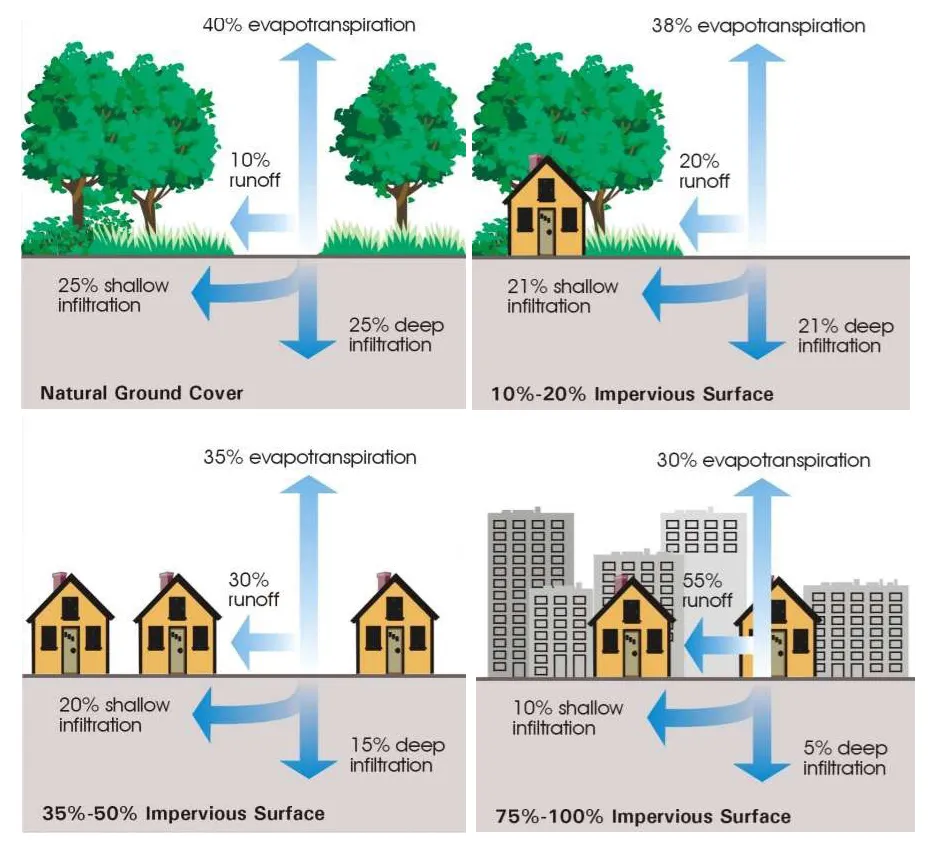
1) Types of “Drainage”?
There are two systems of drainage which should be kept separate: ‘foul’ and ‘surface water’
- Foul drainage:
- It carries the used water from toilets, sinks, basins, baths, showers, bidets, dishwashers and washing machines.
- Surface water drainage:
- It carries rainwater (and melted snow and ice) from hard surfaces.
- The above-ground system of gutter or rainwater pipes is referred to as roof drainage; the underground pipework is referred to as surface water drains and surface water sewers.
3) Requirements for rainwater drainage
- An adequate system of rainwater drainage shall be provided to carry rainwater from roofs of the building and paved areas around the building to one of the following, listed in order of priority:
- Soak ways
- Strom water sewer
- Collection in storage tanks
- Adequate provision shall be made for rainwater to be carried from the roof of the building.
- There should be sufficient number of rain-water pipes of adequate size.
- Rainwater pipes should be so arranged, jointed and fixed as to ensure that the rainwater is carried away from the building without causing dampness in any part of the walls or foundations of the building or those of an adjacent building.
- Rain-water pipes conveying rain- water shall discharge directly or by means of a channel into or over an inlet to a surface drain or shall discharge freely in a compound, drained to surface drain but in no case shall it discharge directly into any closed drain.
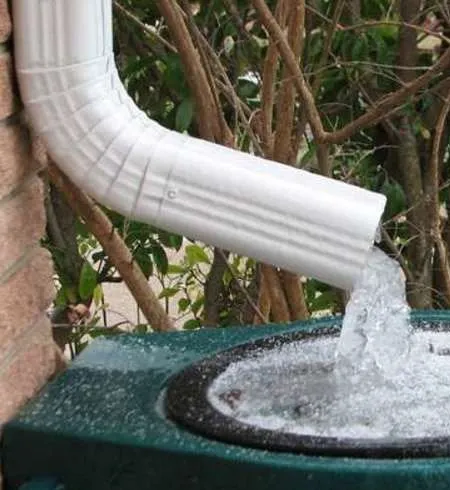
- Whenever it is not possible to discharge a rainwater pipe into or over an inlet to a surface drain or in a compound or in a street drain within 30 m from the boundary of the premises, such rain-water pipe shall discharge into a gully trap which shall be connected with the street drain for storm water and such a gully trap shall have a screen and a silt catcher incorporated in its design.
- A rainwater pipe shall not discharge into or connect with any soil pipe or its ventilating pipe or any waste pipe or its ventilating pipe nor shall it discharge into a sewer unless specifically permitted to do so by the Authority, in which case such discharge into a sewer shall be intercepted by means of a gully trap.
- Rain-water pipes shall be constructed of cast iron, PVC, asbestos cement, galvanized sheet or other equally suitable material and shall be securely fixed.
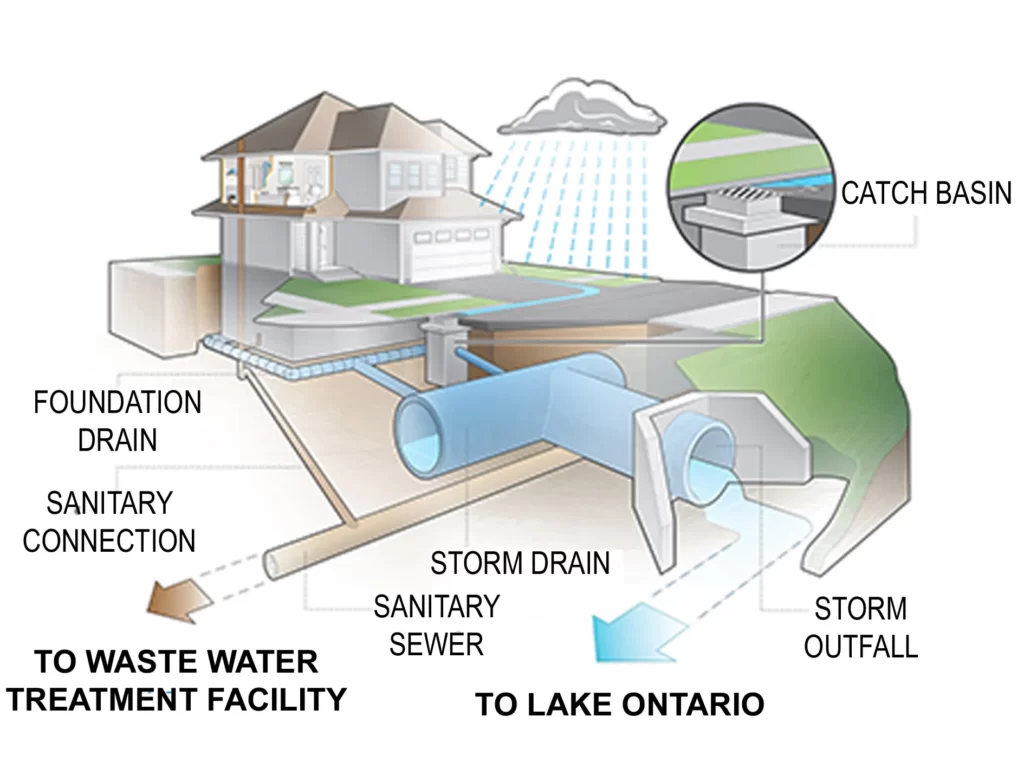


- A bell mouth inlet at the roof surface is found to give better drainage effect, provided proper slopes are given to the roof surface.
- The spacing of rain-water pipes depends on the locations available for the down takes and the area which each pipe serves.
- The spacing will also be determined by the amount of slopes that can be given to the roof, The recommended slopes for the flat roofs with smooth finish would be 1:150 to 1:133, with rough stone/tiles 1:100 and for gravel set in cement or loosely packed concrete finish 1:75 to 1:66.
- The effective strainer area should preferably be 1.5 to 2 times the area of pipe to which it connects to considerably enhance the capacity of rainwater pipes.
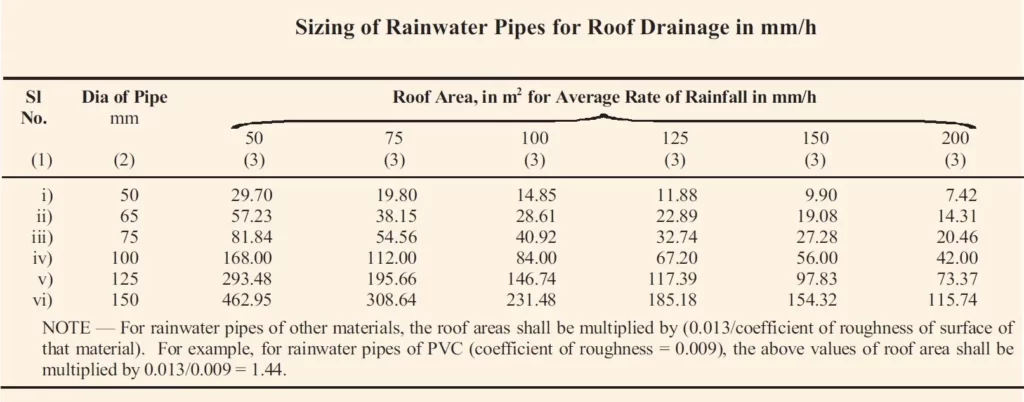

5) The drainage can be derailed into:
- Road surface drainage
- Sub soil drainage
- Infiltration into the ground for recharging of ground water table.
- Disposal of storm water.
i) Road surface drainage

- It is an important factor to remove all the water from road surface at the least possible time, so that structural integrity of overall cross-section of the road is maintained, good riding quality of road will enable in saving vehicle operation cost, if surface runoff, of rain water is efficient.
- The study of pavement drainage for both flexible and rigid pavements has resulted in arriving at a decision that the construction shall be treated as a series of permeable layers and added precautions are necessary to protect the sub-grade.
- All structural elements of road from wearing coat to sub-grade, footpath etc. will deteriorate leading to major maintenance, if efficiency of disposal system is inadequate.
- One major cause of pothole formation on road surface is due to inadequate storm water disposal mechanism. In the event of road profile is not constructed with necessary camber and maintained to desired standards, the disposal of rain water will not be quick and efficient, resulting in pooling of water on the carriageway, deteriorating the pavement cross-section, leading to skidding, which will result in causing inconvenience to other vehicle in addition to self-driven vehicle, causing accidents.
ii) Sub soil drainage
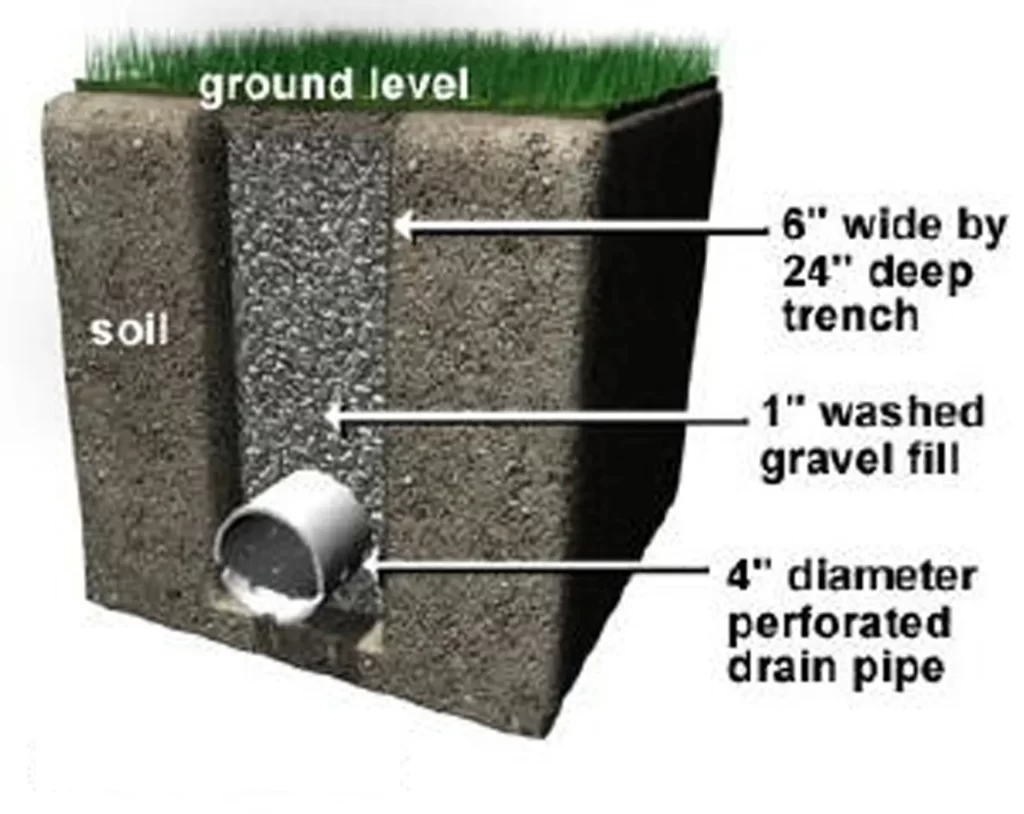
- Most of the sub soil drainage locations are localized. This water shall be collected by subsurface drainage systems which in turn discharge into a drainage system clear
- Draining materials and introduction of membrane has helped control the migration of fine particles from sub-grade specially while pumping, as relatively small migration of fines from sub-grade into voids in the sub-base can seriously reduce the capacity of the sub-base to act as a lateral drain.
- The sub soil drainage shall be sustainable for stability of pavement within design parameters.
- Highest precaution shall be exercised when water logged soil below sub-grade may cause serious damage to the road crust.
iii) Infiltration into the ground for recharging of ground water table

- The storm water disposal system will be highly efficient, if infiltration into the ground is made a part of urban drainage.
- The primary advantage will be reduction in quantum of water at final disposal location. Secondary advantage will be recharging urban ground water which is depleting at alarming rate.
- Infiltration of storm water shall commence at street drains and shall be continued all along conveying system.
- Different suitable mechanisms shall be adopted for infiltrations, like providing filter mediums of certain length or providing filter bed at alternate junctions etc.
- Infiltration will also take place at detention and retention facilities where storm water can be controlled qualitatively and quantitatively.
- In the present state of rapid urbanization, this method will assume greater significance in the Indian content as storm water needs to be conserved while it is made to run off.
iv) Disposal of storm water.

- In the present scenario of rapid urbanization, the adverse impact of development activity needs to be mitigated.
- Urban storm water management practice has to be employed for benefit of storm water control and pollutant removal capabilities.
- Water quality practices shall be adopted of acceptable standards while disposing off of storm water.
- Generally, urban storm water management practice shall adopt high pollutant removal for non-soluble particles pollutants such as suspended sediments.
- In the global scenario of recycling of available water, continuous disposal of contaminated water will seriously jeopardise the availability of potable water.
- In such circumstances, addition of recycled water to available fresh water is becoming a popular option and is in existence in a few parts of the world.
- All possible efforts shall be made for continuous and constant removal of pollutants in the drainage system.
- All available open tanks, parks, nearby quarry pits shall be modernized effectively and utilized as detention and retention ponds and new additional ponds in the flow stream shall be created and added.
6) Drainage water can be dispoded off by:
- Over the surface
- In open channels
- In covered drains
- In flat terrain
i) Drainage Over the surface

- The run-off of surface water will be at kerb side initially and later let off into drains through inlet structures, access holes and junction chambers.
ii) Drainage through open channel
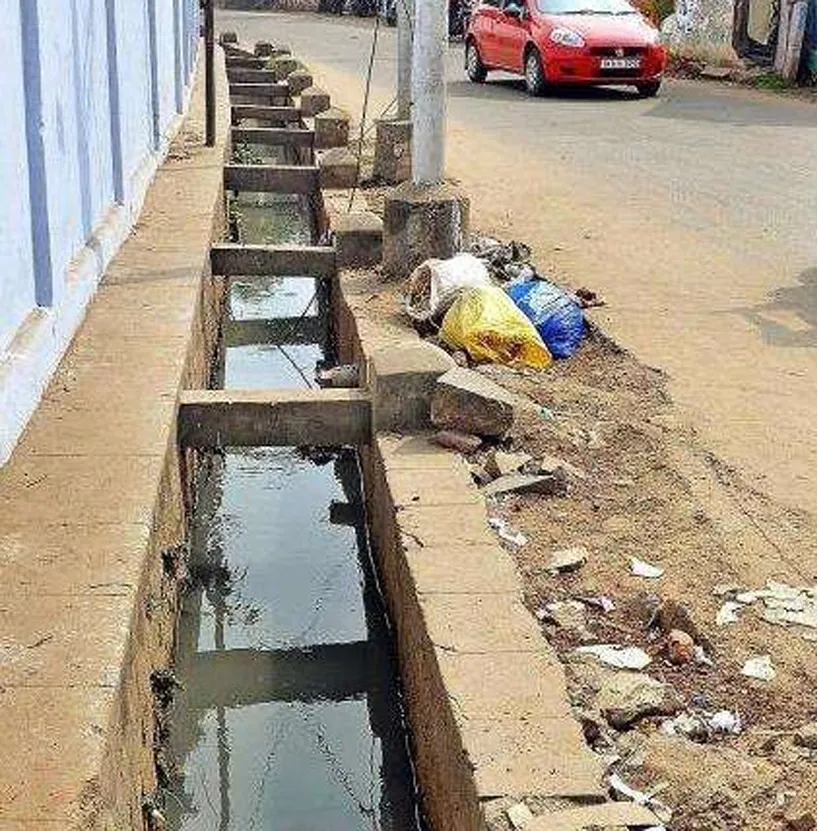
- The open drain along road side shall preferably be at the edge of right-of way of road, as it has dual advantage of transportation of water as well as demarcation of road property.
- These drains are more efficient as they carry larger discharge particularly in flood conditions when drainage is surcharged.
- These drains are easier to maintain and allow for removal and disposal of silt and other solids.
iii) Covered drains

- Covered drains can be located at edge of right of- way, below footpath or even below the carriageway, where the road is narrow, as in newly added areas/ revenue packets and road land is encroached, RCC box drains designed to take vehicular load may be provided.
- The location and size required can be accommodated at a suitable position in the right-of-way so that inspection, silt removal and its disposal can be carried out without any hindrance.
- Concrete pipe drains of appropriate shapes as circular, elliptical, pipe arch, horse-shoe can be used.
iv) Flat terrain
- Disposal of storm water in flat terrain is a tricky affair, as conveyance will be very slow or nil due to zero or near zero
gradient. - The ideal mechanism in such situations is to increase the sectional dimensions of drains and introduce filter mediums in the external surface of drain, with necessary outlets, so that storm water can effectively be disposed off.
- Retention ponds at frequent intervals in available Government lands, parks, large private properties etc., shall be provided with necessary gradient for conveying system for disposal of water.
7) Disposal of storm water
It is essential to dispose off the rainwater into one of the following natural bodies:
- River system
- Coastal waters
- Flood plains
- Water bodies and natural reservoirs
- Underground strata
i) River system
- Disposal of storm water into river system can be considered at locations if water is not being taken for water supply from its downstream side.
- Discharge of rainwater into river needs to be allowed depending on the environmental conditions which shall be foreseen.
ii) Coastal areas
- Problems arising due to high tide shall be clearly understood. Similar would be the case when the ultimate disposal is into the river system.
- In most of such systems, during high floods sluice gates, which are controlled by flood department, are closed resulting in back flow.
- In such cases, where such a situation is likely to create critical conditions during heavy downpour, pumping may have to be resorted for discharging water above HFL.
- Self-regulatory holding ponds having sluice gates with one way water movement are a solution in tidal situations.
iii) Flood plains
- Possibility of demarcating some low laying areas where surplus water from the drains can be temporarily allowed to impound for some time may exist.
- Such systems shall be well designed not only for the entry of the storm water but for exit of the storm water. Also after retreat of storm, the drains do not no longer discharge their peak flows.
- Desalting of such ponds and maintaining of environment shall be well designed.
iv) Water bodies
- These had a historical and ecological significance but down the line due to urbanization, their size is reducing, encroached upon and many sewers open into them making it toxic tanks almost devoid of any life.
- Rapid urban growth and insensitive planning of road network is destroying natural heritage value which otherwise were directly used as natural catchment area.
- As on alternative, retention ponds at frequent intervals in available government lands, parks, large private properties etc., shall be provided with necessary gradient for conveying system for disposal of water.
v) Underground strata
- There are many instances where storm water drainage leads to dead end, especially in large built-up areas. This happens due to poor topography to lead off storm water in thickly built-up areas. In such circumstances, only viable option is to dispose off the rainwater into underground strata and further stagnated water needs to be pumped out.
- Subsurface water is likely to get contaminated due to this system, where it needs careful examination. However as stated earlier due to depletion of ground water table, this method of disposal in to sub surface will be of added advantage rather than considering its negative impact.
- A vertical drainage disposal system into underground strata in built-up.
Area’s is described briefly below:
- The method is designed to dispose the storm water into the permeable strata below the ground level in built-up area, where there is no side drain functioning.
- A vertical borehole of adequate diameter is made, the bottom of which is taken to at least 50 cm into the permeable layer. The borehole is then filled with brick bats or stone aggregates.
- To prevent clogging of the vertical drains, it is wrapped with non-woven geofabric or HOPE woven geofabric without lamination. The top portion of the vertical drain is covered with filter material for a depth of 15 cm. The number and spacing and diameter of the drains depend upon:
- The permeability of the strata at which the water is finally to be disposed.
- The rainfall of the area
- Extent of area to be covered
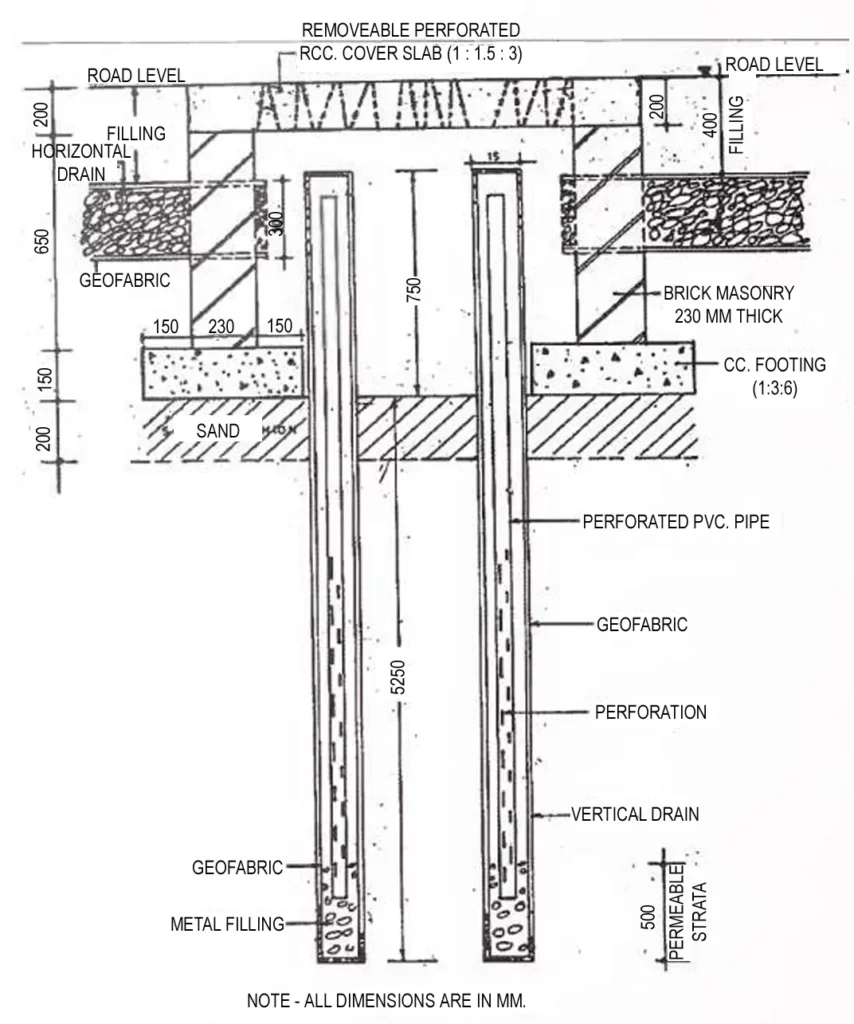
- The vertical drain proposed may be constructed in conjunction with the horizontal drain to increase the rate of disposal. The vertical drain portion may also be modified by introducing a perforated PVC pipe wrapped with geo textile inside the borehole instead of filling it with brick bats. The method has been tried and found to be successful.
- The schematic arrangement for the system is shown in Figure. Any alternate method suiting to local soil condition shall be adopted for satisfactory disposal of rainwater.
8) Rainwater harvesting
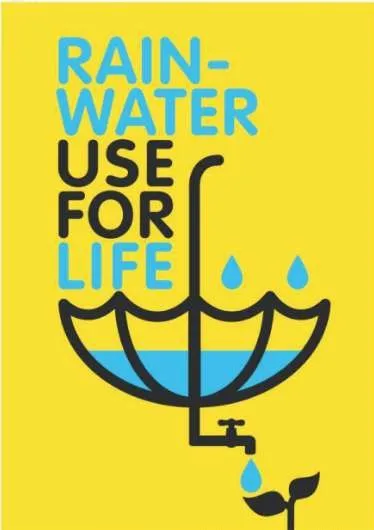
- Domestic Rainwater Harvesting or roof top Rainwater Harvesting is the technique through which Rainwater is captured from roof catchments and stored in tanks/ reservoirs/ Ground water aquifers.
- It requires connecting the outlet pipe from roof top to divert collected water to existing well/tube well/ bore well.
- The rainwater collected can be stored for direct use or can be recharged into the underground aquifers. In scientific terms water harvesting refers to collection and storage of rainwater from the rooftops. This also restricts evaporation and seepage into building foundations.
- All buildings having a plot size of 100 sq.m. or more, shall mandatorily include the complete proposal of rainwater harvesting.
A rainwater harvesting system consists of:
- Roof /catchment: surface upon which rain falls
- Gutters : transport channels from catchment surface to storage
- Down pipes
- Rain water/ Storm water drains
- Filter Chamber: system that remove contamination and debris.
- Storage Tanks/ Pits/ Sumps: where collected rain water is stored
- Ground Water recharge structures like pit, trench, tube well or combination of above structure.
9) Rainwater Harvesting Techniques
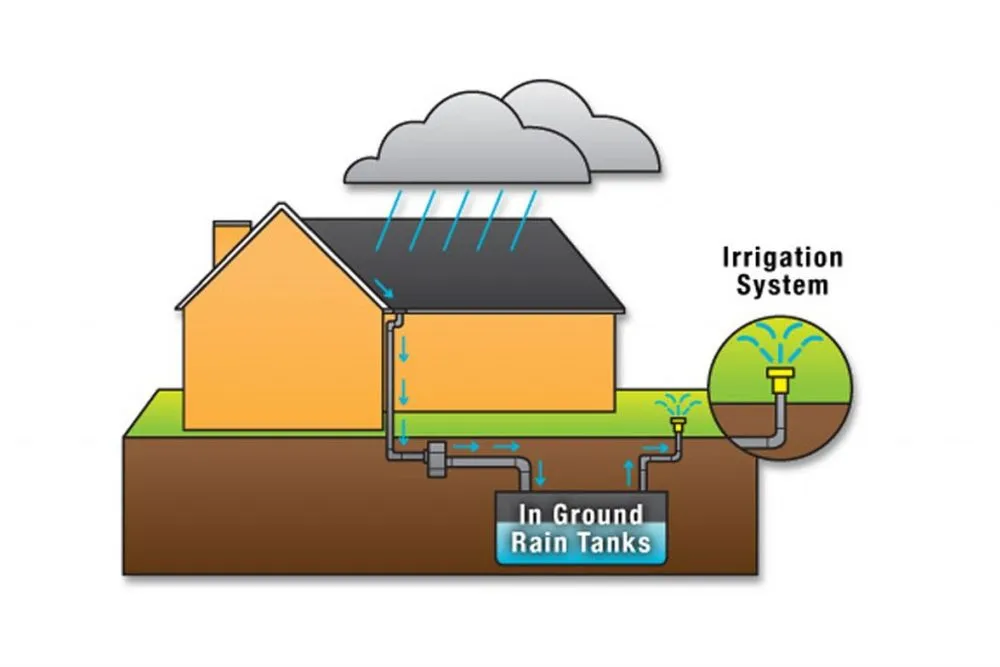
There are two main techniques of rainwater harvesting:
- Storage of rainwater on surface for future use.
- Recharge to ground water.
10) Rainwater Harvesting Requirements
- Down pipes must not be more than 15m apart.
- Down pipes should be discharged into channels, onto concrete slabs or into pipes.
- Storm water is normally conveyed by means of shallow brick or concrete channels, flumes or concrete pipes.
- No pipes of less than 200 mm diameter should be used.
- Pipes draining roads should not be less than 300 mm.
- The size of the concrete storm water pipe depends on:
- The surface of the area e.g., roof surface; rocky, clay, or sandy ground; grassed surface etc.
- Gradient of the ground
- Gradient of the pipe
- region (inland, Cape coastal area, etc.)
11) Basic principles of rainwater harvesting

- Water harvesting in its broadest sense can be defined as the collection of run-off rainwater for domestic water supply, agriculture and environmental management. Water harvesting systems, which harvest runoff from roofs or ground surfaces fall under the term rainwater harvesting.
Each rainwater harvesting system consists of three basic components:
- Catchment or roof surface to collect rainwater.
- Delivery system to transport the water from the roof to the storage reservoir (gutters and drainpipes)
- Storage reservoir or tank to store the water until it is used. The storage reservoir has an extraction device that- depending on the location of the tank- may be a tap, rope and bucket, or a pump.
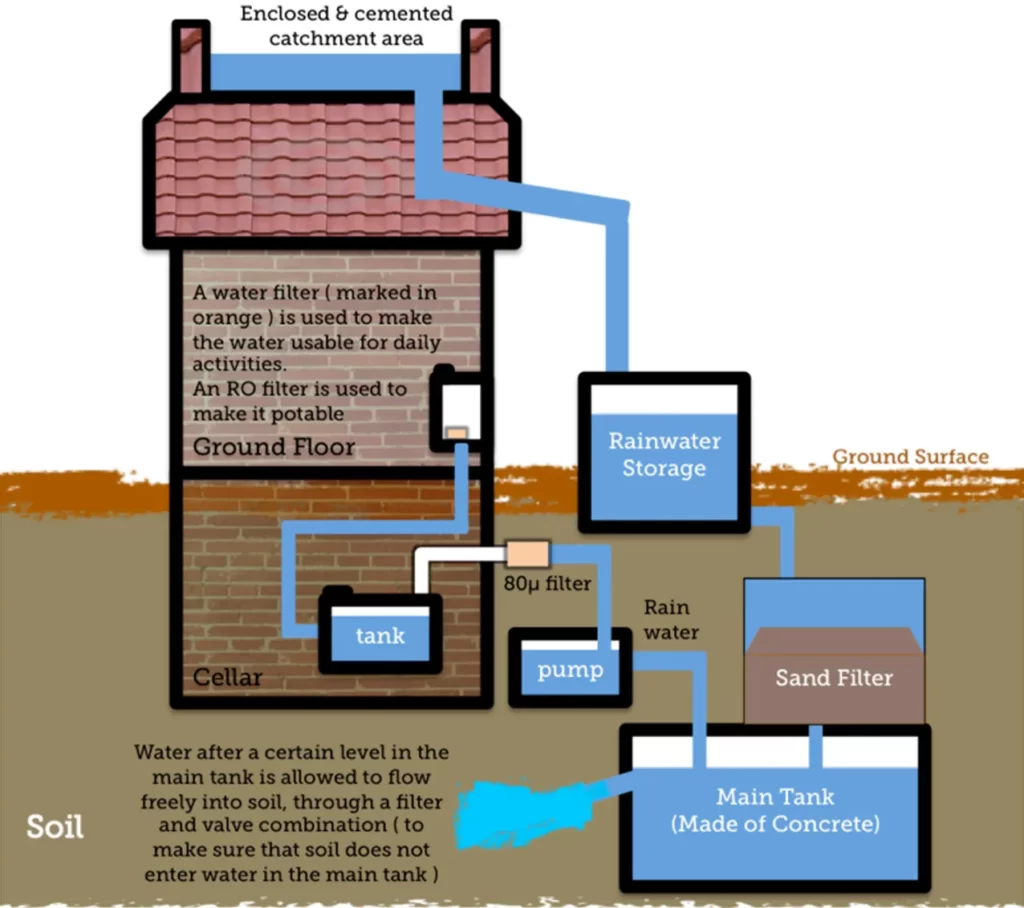
12) Recharge Through Abandoned Dug Well
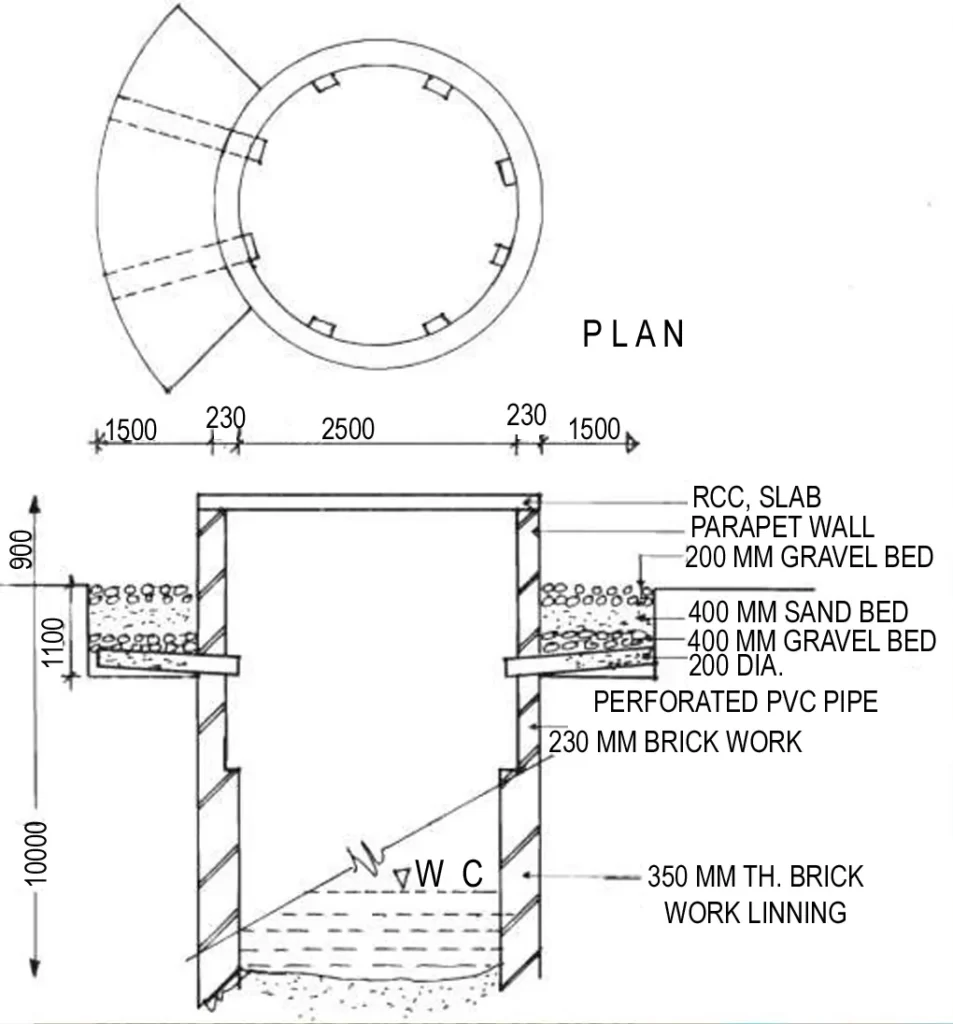
- Existing and abandoned dug wells may be utilized as recharge structure after cleaning and desilting the same.
- The recharge water is guided through a pipe from desilting chamber to the bottom of well or below the water level to avoid scouring of bottom and entrapment of air bubbles in the aquifer.
- Recharge water should be silt free and for removing the silt contents, the runoff water should pass either through a desilting chamber or filter chamber.
- Periodic chlorination should be done for controlling the bacteriological contaminations.
13) Recharge through hand pump
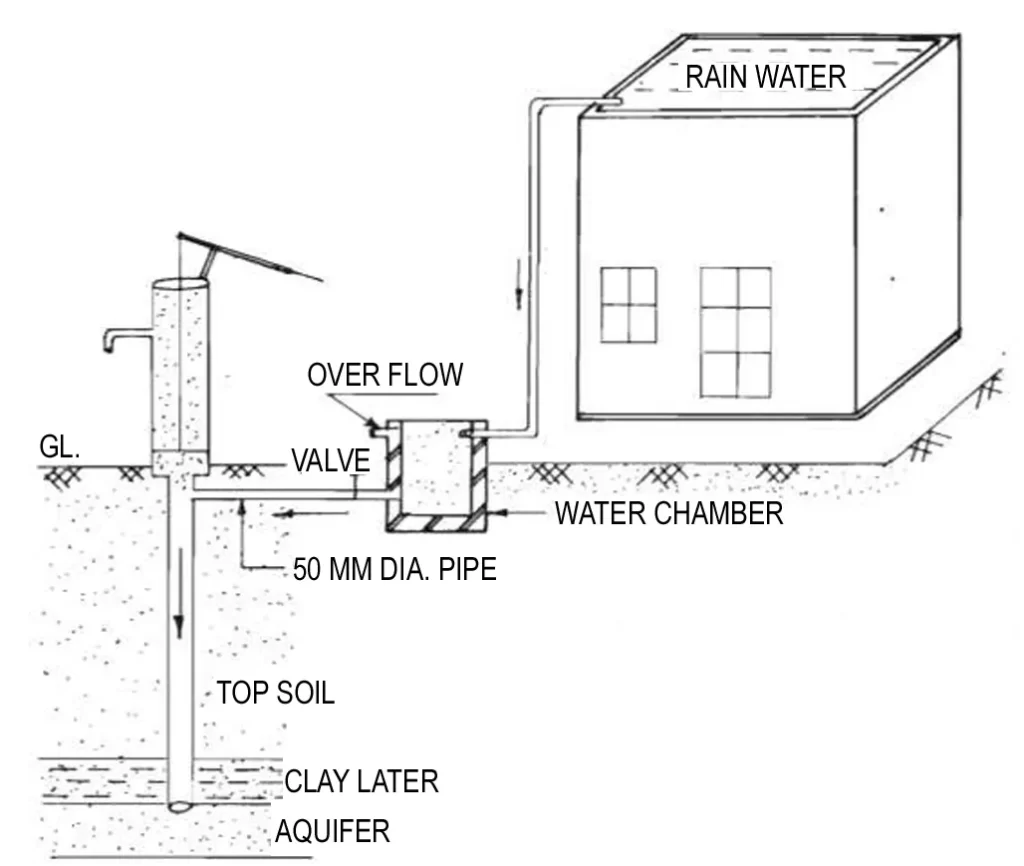
14) Recharge through hand pit
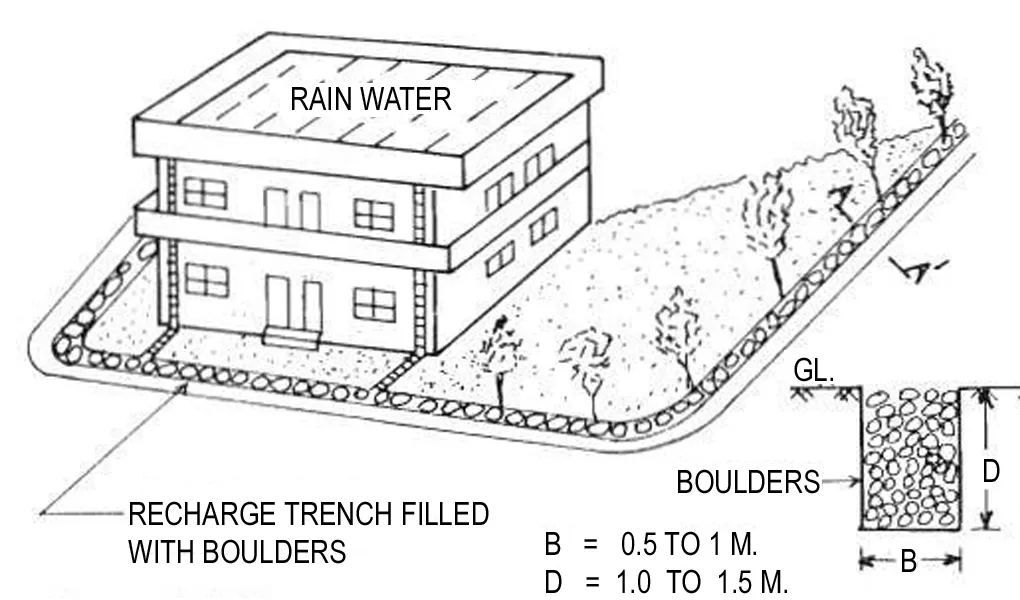
- Building area 200-300 sq.m.
- Trench 0.5 to 1 m wide, 1 to 1.5m. deep and 10 to 20 m. long depending upon availability of water to be recharge.
- These are back filled with boulders (5-20cm), gravel (5-10 mm) and coarse sand (1.5-2 mm) in graded form – boulders at the bottom, gravel in between and coarse sand at the top so that the silt content that will come with runoff will be coarse sand at the top of the sand layer and can easily be removed.
- A mesh should be provided at the roof so that leaves or any other solid waste/debris is prevented from entering the trenches.
Regardless of the type of rainwater disposal system you choose, it is important to ensure that it is properly installed and maintained to ensure that it functions effectively and efficiently. Regular cleaning and maintenance can help prevent clogs and other issues that can cause water damage to buildings and other structures.
Thank you for sharing this informative article.